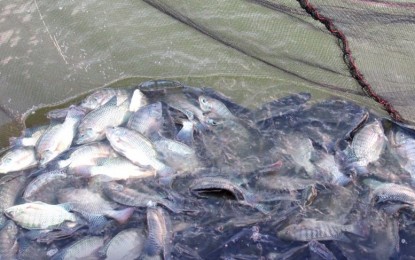
TILAPIA HARVEST. Some of the cultured tilapia during an initial harvest in Baybay City in this April 28, 2020 photo. The Bureau of Fisheries and Aquatic Resources (BFAR) is eyeing Baybay City as the region’s champion for tilapia fish farming following the training of farmers on upland fish production. (Photo courtesy of BFAR Region 8)
TACLOBAN CITY – The Bureau of Fisheries and Aquatic Resources (BFAR) is eyeing Baybay City as the champion for tilapia fish farming in Eastern Visayas following the training of farmers on upland fish production.
BFAR Regional Director Juan Albaladejo said the city is ideal for tilapia farming due to its soil quality, water viability and topography.
The local government has been supporting the training for farmers and fisherfolk associations.
“We already signed an agreement with the city government on the implementation of several fishery-related programs. These projects include installation of intensive tilapia in tanks, construction of fiberglass boats, and post-harvest related activities,” Albaladejo told the Philippine News Agency in a phone interview on Monday.
On July 24, the Baybay’s fisherfolk belonging to 17 associations stocked 59,000 tilapia fingerlings. Four of these groups will engage in intensive tilapia culture and will also be provided with the start-up feeds by the fisheries bureau.
These fishermen, Albaladejo said, recently completed the aqua-based business school modules, undergoing four phases of the training program, which consist of the actual implementation of the program on-field.
“After two months of culture, these enrollees are expected to produce at least 10,000 kilograms of tilapia and at the same time, their training on the aqua-based business school program will come to a close in its module 5 entitled the harvest festival,” Albaladejo said.
The city’s fisherfolk are expected to engage in agri-business by sustaining their own aquaculture ventures.
Baybay is a first-class city in Leyte province with a population of about 110,000 people.
The city houses a major port on the central west coast of Leyte that caters to ferries that travel to and from Cebu and other islands.
Tilapia is the second most important fish cultured in the Philippines next to milkfish.
At present, the culture of tilapia is still an expanding industry in the country, according to BFAR. (PNA)
